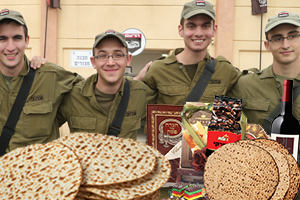A rare archaeological find offers fresh insight into the biblical era of King David, as recorded in Scripture, and ancient Jewish history in the Land of Israel.
A unique inscription from the time of King David was discovered at Khirbet Qeiyafa in the Valley of Elah, Israel’s Antiquity Authority (IAA) announced Tuesday.
The Valley of Elah, located near the modern city of Beit Shemesh, is famous as the spot where the Israelites were encamped when David slew the giant Philistine warrior Goliath.
A roughly 3,000-year-old ceramic jar broken into numerous shards was discovered in 2012 in excavations carried out by Professor Yosef Garfinkel of the Institute of Archaeology of the Hebrew University of Jerusalem and lecturer Saar Ganor, directors of the IAA’s Khirbet Qeiyafa Archaeological Project. Letters written in ancient Canaanite script could be discerned on several shards, sparking the curiosity of researchers.
Intensive restoration work conducted in the laboratories of the IAA’s Artifacts Treatment Department, during which hundreds of pottery shards were glued together to form a whole jar, solved the riddle – the jar was inscribed with the name: Eshba’al Ben Bada.
“This is the first time that the name Eshba’al has appeared on an ancient inscription in the country,” Garfinkel and Ganor stated. “Eshba’al Ben Shaul, who ruled over Israel at the same time as David [when the Kingdom was divided], is known from the Bible. Eshba’al was murdered by assassins and decapitated and his head was brought to David in Hebron as described in the Book of Samuel II, chapters 3-4.”
“It is interesting to note that the name Eshba’al appears in the Bible, and now also in the archaeological record, only during the reign of King David, in the first half of the 10th century BCE. This name was not used later in the First Temple period. The correlation between the biblical tradition and the archaeological finds indicates this was a common name used only during that period. The name Bada is unique and does not appear in ancient inscriptions or in the biblical tradition,” the scholars added.
The fact that the name Eshba’al was engraved on a jar suggests that he was an important person, the experts say. He was apparently the owner of a large agricultural estate, and the produce collected there was packed and transported in jars that bore his name. This is clear evidence of social stratification and the creation of an established economic class that occurred at the time of the formation of the Kingdom of Judah.
“In II Samuel there was apparently reluctance to use the name Eshba’al, which was reminiscent of the Canaanite storm god Ba’al, and the original name was therefore changed to Ish-Boshet, but the original name of Eshba’al was preserved in the Book of Chronicles,” said Garfinkel and Ganor. “Thus, for example, the name of the warlord Gideon Ben Joash was also changed from Jerrubaal to Jerubesheth.”
A Complete Biblical City Exposed
Khirbet Qeiyafa is identified with the biblical city Sha’arayim. During several seasons of excavations directed by Garfinkel and Ganor, a fortified city, two gates, a palace and storerooms, dwellings and cultic rooms were exposed.
The city dates from the time of David, in the late 11th and early 10th centuries BCE.
Unique artifacts, previously unknown, were discovered at the site. For example, in 2008, the world’s earliest Hebrew inscription was uncovered. Another inscription from the same period is now revealed.
Garfinkel and Ganor said that “until about five years ago, we knew of no inscriptions dating to the 10 century BCE from the Kingdom of Judah. In recent years four inscriptions have been discovered: two from Khirbet Qeiyafa, one from Jerusalem and one from Beit Shemesh. This completely changes our understanding of the distribution of writing in the Kingdom of Judah and it is now clear that writing was far more widespread than previously thought. It seems that the organization of the kingdom required a cadre of clerks and writers and their activity is also manifested in the appearance of inscriptions.”
By: United with Israel Staff

Free Ebook: 10 Best Places to Visit in Israel
The Land of Israel has provided the backdrop for some of the most important events in human history. From the Old City in Jerusalem to the Sea of Galilee, people from all over the globe visit the Holy Land each year to take in the breathtaking scenery and inspiration of Israel. Now you can experience this beauty for yourself from the comforts of home and maybe plan a trip of your own to Israel. Get the free, exclusive eBook from United with Israel: The 10 Best Places to Visit in Israel.
Send Passover Packages to Needy Israeli Soldiers - Bring Them Joy!
We are honored to thank the young men and women of the IDF who risk their lives every day to protect the citizens of Israel. Since October 7th, soldiers have been on the battlefield for months - many are hoping to come home for Passover.
Join us in sending Passover food packages (and personal notes) to Israeli soldiers and their families.
Many soldiers spend the Passover holiday with needy families back home. The soldiers greatly appreciate your love and concern. Bring them Passover joy!
CLICK HERE TO SEND YOUR PACKAGE AND NOTE TO ISRAELI SOLDIERS!



